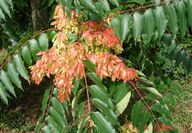Sorted by date Results 1 - 7 of 7

There are over 2,900 described species in the milkweed subfamily (Asclepiadoideae) containing herbs, shrubs, vines, and trees. Minnesota is home to 14 native milkweeds, all which are herbaceous perennials. Last month, the Minnesota Weed of the Month highlighted rough potato, a newly discovered vining milkweed from east Asia. Pale swallow-wort (Cynanchum rossicum) is another newly observed vining milkweed native to southwest Russia and Ukraine. Pale swallow-wort is closely related to black swallo...

There are over 2,900 described species in the milkweed family. Minnesota is home to 14 native milkweeds, all of which are herbaceous perennials. In the summer of 2020, a vining milkweed was discovered along the Lake Wobegon Trail by a University of Minnesota Extension Master Naturalist. Though species of non-native vining milkweeds had been documented in Minnesota, this new infestation turned out to be rough potato (Metaplexis japonica). Rough potato is a vining milkweed species from...

Tree of heaven (Ailanthus altissima) is a deciduous tree native to China, Taiwan, and Vietnam. It was brought to the U.S. in the late 1700s as an ornamental shade tree. Today this tree is found in most of the Continental U.S., Hawaii, and Canada. It looks similar to staghorn sumac, ash, and walnut and has a strong, offensive odor that some describe as being similar to rotting peanuts. In 2020, the Minnesota Department of Agriculture changed the regulated noxious weed designation of tree of...

Saltcedar (Tamarix ssp.) or tamarisk were introduced to the United States in 1823 on the East Coast. They were originally planted as ornamentals, to create wind breaks and to provide shade and stabilize streambanks, but their negative impacts have surfaced within the last few decades. Saltcedar were first reported escaping cultivation in the 1870s. In the southwestern United States, they quickly outcompeted native willows and other riparian shrubs and reduce water levels. Although arid regions...

Prairies are one of the most threatened ecosystems in the world. Before European settlers arrived in Minnesota, there were 18 million acres of prairie. Now just one percent remains. Grasslands are highly beneficial ecosystems, and having a healthy plot of native species on your property can directly benefit you. Invasive plants such as spotted knapweed, leafy spurge and common tansy can overtake grasslands. It is best to find and control these invasive plants before they outcompete prairie plant...

The key to effective invasive plant management is disrupting the lifecycle of the plant. Every plant is different and treatment timing for one plant is completely different from another. Creating a multi-year management strategy that targets timing in the lifecycle is necessary for success. Before targeting a plant, it is important to understand the plant and its lifecycle. Wild parsnip (Pastinaca sativa) is a non-native biennial plant that produces a rosette in its first year and bolts,...
Conserving Minnesota’s natural resources can be complex. Fortunately, a network of Master Gardeners and Master Naturalists exist throughout the state to assist with invasive species education, identification, detection, and management. Both Master Naturalists and Master Gardeners are University of Minnesota Extension volunteers who receive location-specific training for Minnesota biomes. Trainees are enrolled in a 40-hour regionally tailored classroom and field course, followed by a capstone project. Volunteers pursue annual advanced t...